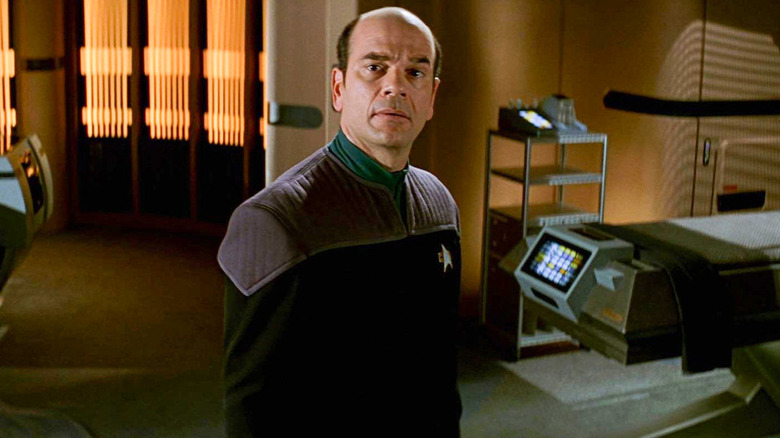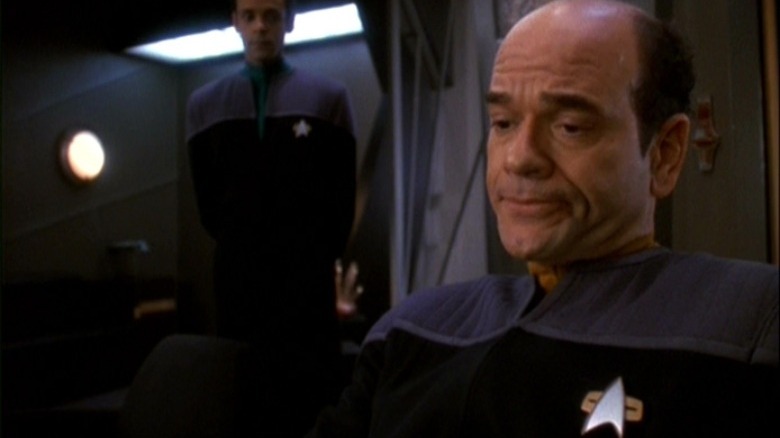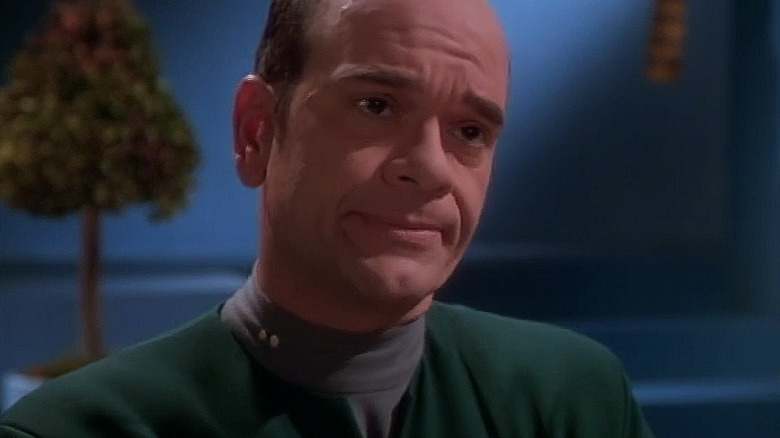How Emergency Medical Holograms In Star Trek Actually Work
In the pilot episode of "Star Trek: Voyager," titled "Caretaker," the U.S.S. Voyager is magically whisked clear across the galaxy by a super-powerful alien seeking compatible DNA it could use for breeding purposes. The Voyager is grievously damaged by the whisking and multiple crew members die, including the ship's entire medical staff. To assist with all the injuries, one of the Voyager crewmates activates the ship's Emergency Medical Hologram, an ultrasophisticated program that holographically projects an artificial doctor into the middle of sickbay.
The artificial doctor — played on "Voyager" by Robert Picardo — is capable of scanning patients, surmising what treatment might be needed, and can even administer medicine or perform surgery (the EMH has tangible substance thanks to force fields). Because he was designed for emergencies, the EMH was programmed to have a snippy, impatient personality. Whenever he is activated, he merely barks out: "Please state the nature of the medical emergency."
EMHs are, in the timeline of "Voyager," a brand-new technology, and not all ships have them. Because the "Voyager" was stranded seventy years from Earth without a medical staff, the crew found they had to leave their EMH running in order to have a doctor at all. Unexpectedly, the EMH begins learning new information, develops a personality, and even develops consciousness. By the end of the series, the EMH will have hobbies, emotions, political causes, and artistic ambitions.
But what are the technical details of an EMH? How prevalent did they become after the events of "Star Trek: Voyager?" And who was the real-life human that the EMH was programmed to look like? Read on, curious Trekkies, and find out.
Dr. Lewis Zimmerman
In early episodes of "Voyager," the EMH mentioned that his program was designed by someone named Dr. Lewis Zimmerman, a human engineer from back on Earth. The EMH didn't have the same personality as Zimmerman, but did look exactly like him. Trekkies would finally get to meet the real-life Dr. Zimmerman in the "Star Trek: Deep Space Nine" episode "Dr. Bashir, I Presume?" In that episode, DS9's chief medical officer, Dr. Bashir (Alexander Siddig) is approached by Dr. Zimmerman as the potential next model for a new series of EMHs that he is developing: the Mark III model (Mark II was played by Andy Dick). The new EMHs would also emulate Dr. Bashir's personality, as the last model lacked bedside manner.
As one might assume, Emergency Medical Holograms are mere projections of people, and don't have blood or organs, or even skin under their uniforms. Indeed, with a few button pushes, an EMH can deactivate its force field function, and become an intangible projection of light. In later episodes of "Voyager," it was explained that the EMH doesn't have genitals, although he did eventually become clever enough to program a set onto his body.
The EMH was originally confined to sickbay, as the sickbay's walls were outfitted with his projectors. Later, clever engineers on the Voyager found a way to transfer the Doctor's massive program onto the ship's holodeck, and he started visiting his own imagined holographic worlds.
The EMH also couldn't initially activate and deactivate himself, as he was only meant to be used for emergencies. As the hologram began developing a consciousness and a sense of agency, though, the same clever Voyager engineers gave him the ability to turn himself on and off at will.
The Doctor's mobile emitter
In the "Star Trek: Voyager" two-parter "Future's End," the Voyager followed a 29th-century, high-tech time traveling spacecraft through a portal to the year 1996. While in the past, the Voyager found that a Bill Gates-like tycoon named Henry Starling (Ed Begley, Jr.) had found the high-tech time-travel craft and was using it to invent modems and CD-ROMs and other then-edgy computer tech. Starling also managed to "kidnap" the EMH, and used the high-tech ship to develop a mobile emitter. The mobile emitter was attached to the holographic doctor's arm, and was capable of projecting his light and force fields wherever it went. It finally allowed the EMH to go wherever he wanted and retain his whole memory and personality.
As the technology evolved, so too did the EMH's functionality. In the "Voyager" episode "Tinker Tenor Doctor Spy" (October 13, 1999), the Doctor proposed that his program was capable of accessing much more than medical expertise, and that he should be allowed to learn about tactical and command responsibilities as well. Later in the episode, he activates a version of himself called the Emergency Command Hologram, and serves as a temporary artificial captain.
In the animated series "Star Trek: Prodigy," it was also revealed that the experimental ship the U.S.S. Protostar had been equipped with Holographic Training Advisor programmed to look like Captain Kathryn Janeway (Kate Mulgrew). Hologram Janeway served as an ersatz professorial figure to the show's cast of untrained teenage characters. She, like the EMH, quickly evolved an seemed to develop her own consciousness. She also was warm and kind, a far-cry from the bitter Admiral Janeway (also Mulgrew) elsewhere in the galaxy.
Hologram evolution
The first season of "Star Trek: Picard" was set in the year 2399, a good 20 years after the conclusion of "Voyager." By then, holographic duplicates seemed to be in common use among even non-Starfleet personnel, and were no longer as specialized as Emergency Medical Holograms. Captain Cristobal Rios (Santiago Cabrera) was in command of a non-Federation ship called the La Sirena, and he required the aid of several holographic twins to run the ship when he couldn't find a crew.
Each one of the Rios duplicates had a slightly different personality, and Raffi (Michelle Hurd) figured she could psychoanalyze the real person by interrogating all the Rios copies at once. Duplicates were a common motif in the first season of "Picard"; Soji (Isa Briones) had two android triplets, Picard (Patrick Stewart) has his consciousness shunted into an android clone, and Brent Spiner appeared in two different roles. So, it made sense that someone would have a holographic twin as well.
The final three seasons of "Star Trek: Discovery" take place in the distant 32nd century. By then, EMHs were apparently standard issue across the federation. A character named Eli (Brendan Beiser) was one of the Federation's holographic doctors, although they said explicitly that he wasn't based on any known human. He was also a sophisticated enough piece of medical equipment that he could scan someone in real time to tell if they were lying. It also might be presumed that Eli was also conscious and offered equal rights under the law, even as a collection of light and force fields.
This was all thanks to the original EMH's efforts.



